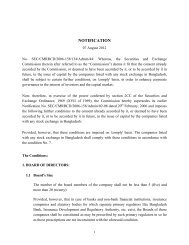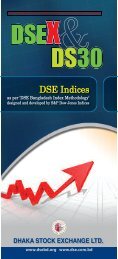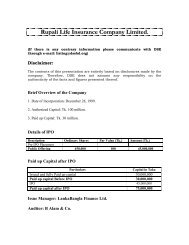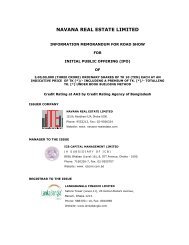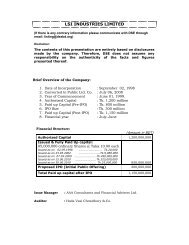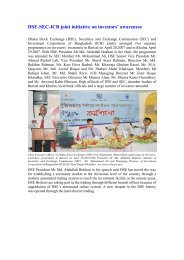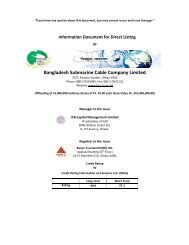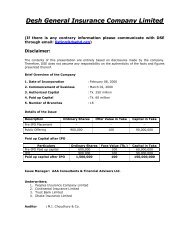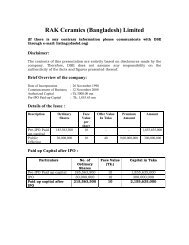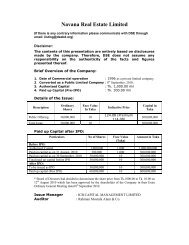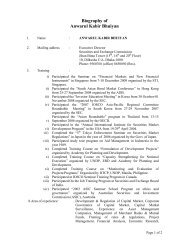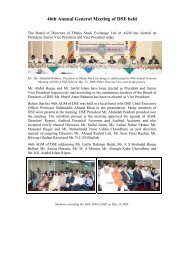Information Document - Dhaka Stock Exchange
Information Document - Dhaka Stock Exchange
Information Document - Dhaka Stock Exchange
- No tags were found...
You also want an ePaper? Increase the reach of your titles
YUMPU automatically turns print PDFs into web optimized ePapers that Google loves.
CREDIT RATING REPORTONKHULNA POWER COMPANY LTD.3.2 United GroupThe United Group is a known name in the business arena of the country. The Group started itsbusiness career in 1978; with its Flagship company United Enterprises and Co. Ltd. During thelast almost three decades of operation, the Group has expanded its business in varioussectors of the national economy such as Power Generation, Broadcasting and Communication,Civil and Hydro Engineering, Real Estate Development, Land port Services, Hospital andhealth care, Textiles, Polymer industries, Education etc.Over the years, the Group has completed several large and unique projects that testify itsstrength and capability in project management. Such projects include the 110 MW bargemounted power plant in Khulna; 60 km Coastal Embankment Rehabilitation Project financedby the World Bank; three 11 MW power plants in Ashulia, Narshingdi and Comilla; 450 bedState -Of-The-Art hospital; Runway Overlay Project at Zia International Airport; E-cash ATMCard Networking System; land port management services at Teknaf (ongoing) and others. Atend of 2008, the asset base of the group stood at Tk. 16,395.35 million against Tk. 10,482.16million liabilities. Net worth of the group stood at Tk. 5,913.18 million and net profit for thelast period reached to Tk. 343.58 million.4.0 PROJECT/PLANT DETAILSPlant located at nearKhulna cityGuaranteedpayment for 50% ofdeemed generationPage 3 of 154.1 Plant Location & Production FacilitiesThe plant is located near the city of Khulna. The riverbank project site provides easy access tofuel shipments by river and is located next to an existing electrical substation andtransmission line. The plant consists of two barge-mounted facilities housing of a total 19Wartsila diesel engine generators of 6.5 MW capacities. Generators are featured with low NOxand dual fuel capability. Nine engines-generators are mounted on one barge and ten on theother. The barges, shipped as deck cargo on a submersible dry tow ship, are moored in aclosed basin. Each barge is approximately 91 meters long and 24 meters wide. The plant’sshore side auxiliary facilities include two Heavy Furnace Oil (HFO) storage tanks (7,500 cubicmeters each) and pumps to transfer heavy fuel oil to a buffer tank on either barge.4.2 Main Features of PPAConsidering the BPDB as the single buyer, the Power Purchase Agreement between BPDB andKPCL plays a very important role. The PPA inter alia includes the following importantprovisions:a) The term of the contract is for 15 years from the date of commercial operations;b) BPDB is committed to a minimum guaranteed payment equivalent to 50% plantfactor on a monthly basis;c) Two part monthly tariff structure: Fuel Tariff (FT); with full cost pass through andOther Monthly Tariff (OMT), 99% of which is US$ indexed;d) Allows KPCL to source its own fuel supply;e) Tariff invoices payable within 45 days of the delivery of invoices;f) Payment security back-up in the form of Letter of Credit covering two monthsminimum tariff payments;g) The minimum tariff payment obligations continue through political and Force MajeureEvents;h) Compensation amount on termination to cover 65% of the NPV of the minimum tariffpayment for the remaining term of the PPA, plus consequent termination paymentliability to KPCL in respect of the O&M agreement and Fuel Supply Agreement, plustaxes;i) KPCL is required to pay liquidated damages for lower output capacity and shortsupply of energy;j) BPDB would pay liquidity damages to KPCL in the event of failure by the GOB to meetany of; its obligations provided under the Implementation Agreement (IA).4.3 Tariff StructureThe PPA contains a two-part tariff: fuel tariff (“FT”) and other monthly tariff (“OMT”). The FTreflects the pass-through nature of fuel expenses to the extent that the plant operates at thespecified heat rate. Under the tariff structure, the fuel cost is calculated in terms of volumerather than energy content (i.e. $/liter versus $/BTU), since HFO is sold by volume or mass.



